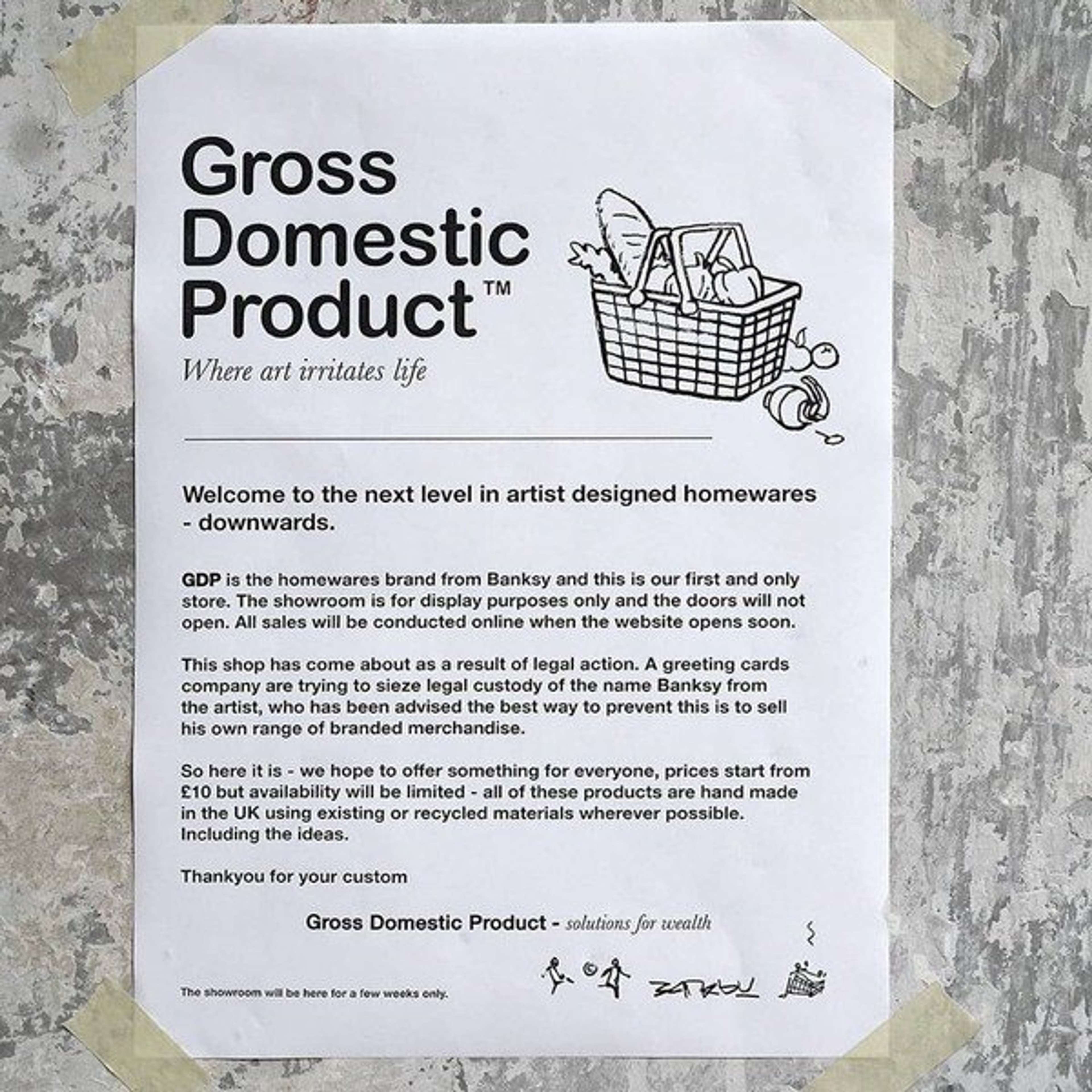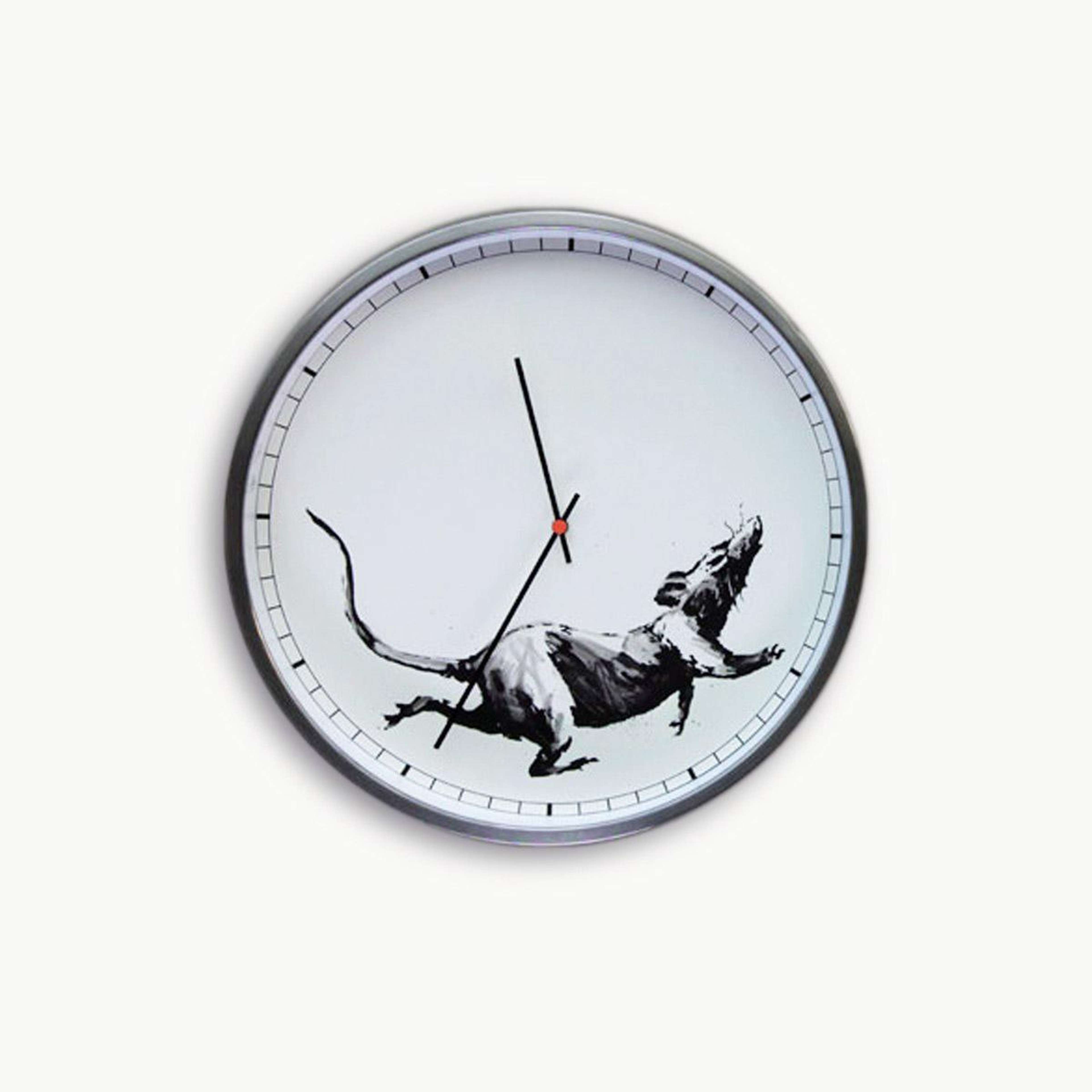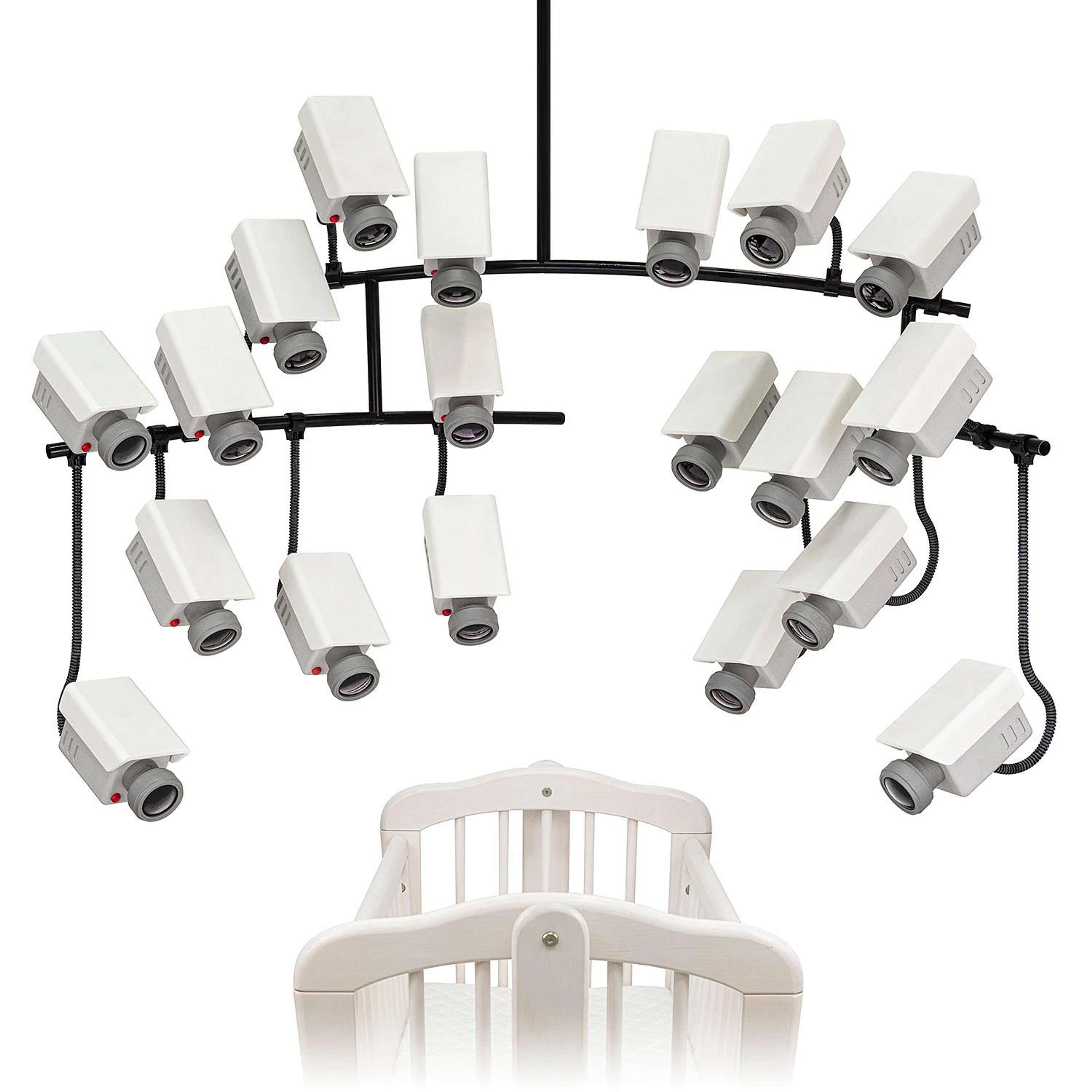 Gross Domestic Product © Banksy
Gross Domestic Product © Banksy
Banksy
269 works
Gross Domestic Product – The Homewares Brand from Banksy™ A carefully crafted publicity stunt or a genuine bid by Banksy to make his work more accessible?
In the Autumn of 2019, Banksy filled a shopfront in Croydon with a collection of new artworks and announced it on social media as his new venture, Gross Domestic Product. Fans flocked from all over the country to get their hands on his latest series of anti-establishment, irony-laden editions only to find that this was unlike any other store or gallery. Instead of entering the shop, buyers were directed to a website where they could register their interest and be entered into a lottery to win just one item, accompanied by a litany of terms and conditions.
As we come up to the two year anniversary of the stunt – and the all important date when Pest Control will release the long awaited Certificates of Authenticity for the GDP editions – we take a closer look at how Gross Domestic Product worked and its lasting effect on the Banksy market.
Why did GDP never open? Was the Banksy shop official?
The shop was indeed the real deal. As is characteristic with Banksy, given his attitudes towards consumerism, however, there was a catch... Rather than operate on the usual ‘first come first served’ basis of retail, Banksy decided to open a kind of lottery cum merit-based system for collectors wanting to buy his work. In order to get your hands on one of his pieces, you had to go to the GDP website and ‘apply’ for a product/artwork. As the website reads, “Gross Domestic Product (GDP) “may prove to be a disappointing retail experience – especially if you’re successful in making a purchase”…
How could people buy artworks from Banksy's GDP?
Firstly, they could only buy one thing. Secondly, they were asked to answer the (age-old) question, ‘Why does art matter?’ Good luck with that one. Their responses were judged by comedian Adam Bloom and if he deemed them funny, enlightening, or original, their name would be entered into a lottery to ‘win’ the chosen artwork. Interestingly, the request for answers was accompanied by a note assuring entrants they would retain copyright of their writing however they were also made aware that their work may be published by Banksy ‘in any media’, suggesting the vast amount of responses could be turned into an artwork themselves…
Why did he do this?
In order to weed out those who are only interested in ‘flipping’ his work on the market, of course. After all the site asked its customers to “Please buy an item because you like it, not because you think it is a good investment.”
After choosing to remain anonymous for decades while his art has become more and more valuable, Banksy has been forced to stand by and watch as fat cats and collectors have made huge profits on his works. His fame is so great that some have even gone as far as tearing down walls that bore his murals, acting in complete opposition to the spirit of this renegade graffiti artist whose art is primarily for the people.
A year before it opened Banksy pulled off an incredible stunt that seemed to epitomise how he felt about the enormity of the secondary market for his art. As the hammer came down on one of his paintings, Girl With Balloon, at Sotheby’s London, a self destruct device was activated and the painting appeared to fall from its frame, only to be shredded as the audience looked on in horror and amusement. The artist later made a video revealing how he had installed the device, “in case it was ever put up for auction.”
Thanks to GDP Banksy was back in the headlines with a shop of his own, bypassing auction houses, galleries and dealers to sell directly to his fans. In order to emphasise the message of accessibility, products can be bought by those on lower incomes for just £10. The website also bears a polite note to collectors hoping to make a quick profit: “Please refrain from registering at this time if you are a wealthy art collector”.
In 2022, Banksy made headlines once again when he urged people to shoplift from the Guess store on Regent Street, London, after the brand used his Flower Thrower imagery without permission. This public call to action highlighted his disdain for the unauthorised commercialisation of his work and reflected his long-standing critique of corporate exploitation. The stunt resonates with the ethos of Gross Domestic Product, where Banksy sought to reclaim control over his art by bypassing traditional art markets and engaging directly with his audience. By framing Guess's actions as a continuation of art being co-opted for profit, Banksy reinforced his anti-capitalist narrative, drawing attention to the ongoing tension between artistic integrity and consumer culture.
Banksy's disdain for the art market will hardly be news for fans of the street artist; from scathing depictions of auction houses, such as his Morons prints to Instagram comments about the value of his work on the secondary market, he has been vocal about his opinions. Undoubtedly, his disdain centers on the capitalist basis of the art market.
For a comprehensive overview of the art market historically, read our A Concise History of the Art Market here.
You can also read more about Banksy's ethos in Banksy and Capitalism: Critic or Champion?
Is this some kind of nod to Keith Haring and his Pop Shops?
Sort of, except this wasn’t an actual shop, remember. By taking the production of merchandise into his own hands Banksy is both making his work more accessible to the people and looking after his brand. It has been reported that he only decided to start this venture after a greetings card company tried to reproduce some of his designs and create a Banksy trademark.
More recently, in 2022, Banksy incited shoplifters to loot the Regent Street Guess store, after the fashion brand used his Love Is In The Air imagery without permission.
With GDP he was able to keep control of his name and sell directly to his fans, much in the way that American street artist KAWS has been operating since the opening of his Original Fake stores in 2006 and now with his website where his new toys are released.
What was for sale in Banksy's shop?
Everything from the Union Jack emblazoned stab vest Stormzy wore on the pyramid stage at Glastonbury 2019 while deriding Boris Johnson, to a handbag made out of a house brick for the kind of person who “doesn’t carry much but might need to whack someone in the face”.
Banksy played with one of his favourite themes, too: childhood. But unlike his graffiti art, where children add poignancy to a political point about the impact of war or other catastrophes, his childhood-related items for Gross Domestic Product err on the edgier side with the Banksy™ Baby Mobile—made up of an array of CCTV cameras—and the Banksy™ Early Learning Counting Set—a Playmobil®-esque toy set featuring asylum seekers and a human trafficker, complete with truck— on offer. Of course, these two examples still make a devastating political point, but it seems that as part of his intention of making these products a challenge to get a hold of, he wants them to be somewhat unpalatable to own too, foregoing the more inspirational flavour of his public art and making them truly challenging objects. In doing so, what he offers for sale is at the furthest remove from the ordinary banality of merchandise and ease of consumerism. More than anything, the works centre around one of the Banksy's key themes: Violence vs Innocence.
As well as unique signed paintings and limited edition prints, at the lower end of the price scale buyers could find selection of mugs and t-shirts – including one with a fringe designed to look like the shredded Girl With Balloon painting – that are available in seemingly infinite amounts. Many of the products seemed to be available in unlimited editions, however the website was quick to point out that ‘All the products are made in an art studio, not a factory.’
The website blended more traditional mediums with collectable objects, speaking to a recent trend in the contemporary art world. If you want to learn more about the role of collectables in today's art market, listen to our podcast: MyArtBroker Talks: The Age Of The Collectable.
Is Banksy making a dig at Warhol?
While Banksy likely has help, like most artists, in producing his editioned prints, it is unlikely to be on the scale of Andy Warhol's studios—or 'The Factory', as each of his four workshops over his career were dubbed— given the mass-produced scale of Warhol's editions. It is quite possible that Banksy makes a dig at Warhol by emphasizing the studio-made nature of his Gross Domestic Product merchandise.
Anyone who is part of the canon or establishment is fair game in Banksy’s oeuvre, yet, the street artist arguably might never have become so big if artists such as Warhol, Basquiat – whom Banksy pays homage to in a print entitled Banksquiat in the shop – and Haring hadn’t paved the way for him in the 20th century by blurring the lines between street and gallery, art and commercialism.
What was the response to Banksy's Gross Domestic Product?
The Art Newspaper described Banksy’s latest stunt in a somewhat skeptical tone, stating that, “It is all dressed up as humorous. … In an art market that is so often far removed from reality, laughter probably is the best recourse.” Speaking to the BBC, their correspondent Anny Shaw said, “It’s a tongue-in-cheek poke at the market while at the same time attempting to wrestle some control of it.”
The BBC arts editor Will Gompetrz, however, appeared to be cynical about buyers’ intentions despite the artist’s efforts to weed out flippers, “With the shop, he’s trading on familiar ground – the relationship between art and commerce. Are they the same, as Andy Warhol famously said? Why does anybody want the product he’s offering, which he warns might disappoint? And yet a lot of people will.”
How did fans respond to the Gross Domestic Product shop?
Across Twitter and Instagram Banksy’s fanbase appear enraptured by the artist’s stunt and clever ploy to make consumers work for their product. One fan stated, “A cushion with the inscription ‘Life’s too short to take advice from a cushion’? SOLD!” while others commented, “I need banksy’s whole new GDP shop collection.” Some however, saw the move as a further ‘selling out’ on the artist’s part, commenting, “Wasn’t Banksy supposed to be art for the people without the need for payment? We all need money to survive I suppose…” and “All of this is really cool stuff but doesn’t the online website kinda go against the whole anti-consumerism idea portrayed in all his art?”
Does Banksy still have an online store? What’s BBay?
Once all the products on GDP were listed as ‘out of stock’, fans became even more eager for the launch of BBay, announced on the shop’s website as ‘The approved used Banksy dealership – coming soon’. Accompanied by a picture of a man at a car boot sale selling Banksy knock offs – or originals – the website bears the tagline “your first choice destination to trade in secondhand work by a third-rate artist”. This appeared to be yet another attempt to wrest control over secondary sales which often reach astronomical prices, becoming inaccessible to both the general public and the artist who sees none of the profits. When his painting of chimpanzees in the House of Commons sold for £9.9million in 2019 the artist chose to comment on the sale with an instagram post that quoted the critic Robert Hughes, “The price of a work of art is now part of its function, its new job is to sit on the wall and get more expensive,” along with the comment, “Record price for a Banksy painting set at auction tonight. Shame I didn’t still own it.”
As of 2022, there have been no further announcements about BBay; it’s possible that Banksy meant to launch the secondary market platform in 2020, but was delayed by the pandemic, but for now buyers looking to get their hands on works from the GDP collection and the artist’s previous work continue to go through galleries, auction houses and online dealers.
Can I buy from Banksy’s Gross Domestic Product?
Given the amount of attention the GDP launch attracted from the press and Banksy fans, it is no surprise that the ‘shop’ was inundated with entries to its unusual application system. Prospective buyers were limited to one product per person however, as expected, demand still outstripped supply and today all items are marked ‘out of stock’.
Banksy fans who missed out can usually turn to the secondary market for solace but while there are many sites and listings for Banksy’s GDP artworks online, it is not advisable to part with your money just yet. When GDP was launched the artist ensured quick sales or ‘flipping’ of artworks would be avoided by forcing buyers to wait two years for the all important Certificate of Authenticity issued by Pest Control. This means that until October 2021 all GDP artworks have not been authenticated and due to the nature of their production – including the use of upcycled household objects and stencils – and large edition size, there will likely be a lot of fakes on the black market.
Can I resell my print from Banksy’s Gross Domestic Product?
While you can usually find a market for Banksy artworks at any time it is advisable to hold onto those GDP editions for a little longer. You can still request a valuation for your work here, and we’ll be in touch to remind you once Pest Control offer us more information.
Once the certificates of authenticity becomes available, at the very earliest October 2021, the artwork will be worth considerably more because buyers will be reassured that your piece is entirely genuine.










